A BIRTHDAY SALUTE TO THE KING: In the latest NEAL ADAMS CHRONICLES, Peter Stone traces Adams’ ever-growing affinity for Kirby…
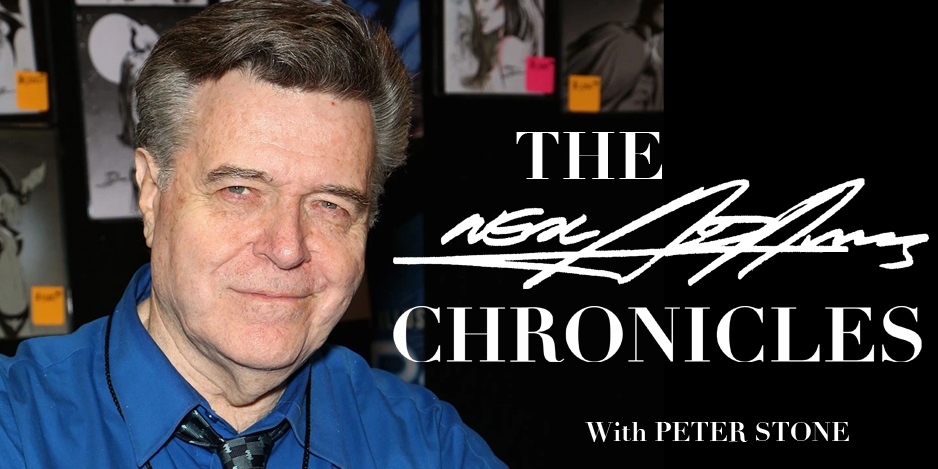
—
Welcome back to THE NEAL ADAMS CHRONICLES, a new, regular feature about comics’ greatest artist, produced in conjunction with Adams’ family. You can read more about what this is all about over here. (You’ll want to.) The centerpiece of the feature is Peter Stone’s ongoing column about his late father-in-law’s perspectives on art, comics and even entertainment. Dig it. — Dan
—
This year, for the late Jack Kirby’s birthday — he was born 106 years ago on Aug. 28, 1917 — we have a trio of tributes by an all-star line-up of Kirbyites: Peter Stone, Fred Van Lente and Chris Ryall, each with their own take on the King’s legacy. The links are at the bottom of the column, so by all means check ’em out. Long live the King! — Dan
—
By PETER STONE
“Just a few bits and pieces from yours truly. I am guessing you are starting to realize how much fun I am having with Jack Kirby’s characters, and the life Jack breathed into them.” – Neal Adams
Like many of us, Neal was not a big fan of Jack Kirby’s art when he was younger. In fact, Neal thought very little about Kirby’s art. IN FACT, Neal kind of hated it. It wasn’t until the late-’50s newspaper strip Sky Masters that he started to enjoy Kirby’s work but assumed that it was Wally Wood’s inking that made that series interesting. Wood’s marvelous inks made the series even remotely readable. However, as a teenager, Neal was already looking for bigger, more exciting stories. Science fiction, superheroes, other worlds or epic storylines. That was Neal’s bread and butter.

Adams inking over Kirby, backed by Kirby collages
Then, within moments (the very same year, 1958), Neal found Challengers of the Unknown from DC Comics. It was written by Kirby and Dick Wood (no relation to Wally) and drawn by Kirby. But for Neal, the magic was that inking… Wally Wood again. Now, in Challengers of the Unknown, the stories were fantastic and full of science fiction. Kirby was involved in the writing, so the plots were way-out-there! It was four years before Fantastic Four and Neal loved the series! However, the love of Kirby was not there yet. It was really based on Wally Wood’s masterful inking. Neal had been a fan of Woody since “Superduperman!” from 1952’s fourth issue of Mad Magazine. So, Woody had to be the magic of Sky Masters and Challengers, right?
Neal had turned me on to early Mad magazine (and by that, I mean the stunning art of Wally Wood, Jack Davis, Will Elder and John Severin along with the stellar, legendary humor writing of Harvey Kurtzman. Mad was Max Gaines and Kurtzman’s child from EC Comics.) This version of Mad was not the more popular magazine from the ’60s and ’70s; the first incarnation was about the funniest, most satirical comic ever done. Mad — and “Superduperman!” — was one of the first comics Neal taught me about. After that, I was hooked on Mad and Kurtzman. I never had the opportunity to meet Harvey, but I have been told he was naturally a very funny dude. (In my humble opinion, he was one of the top five writers in comics ever.)
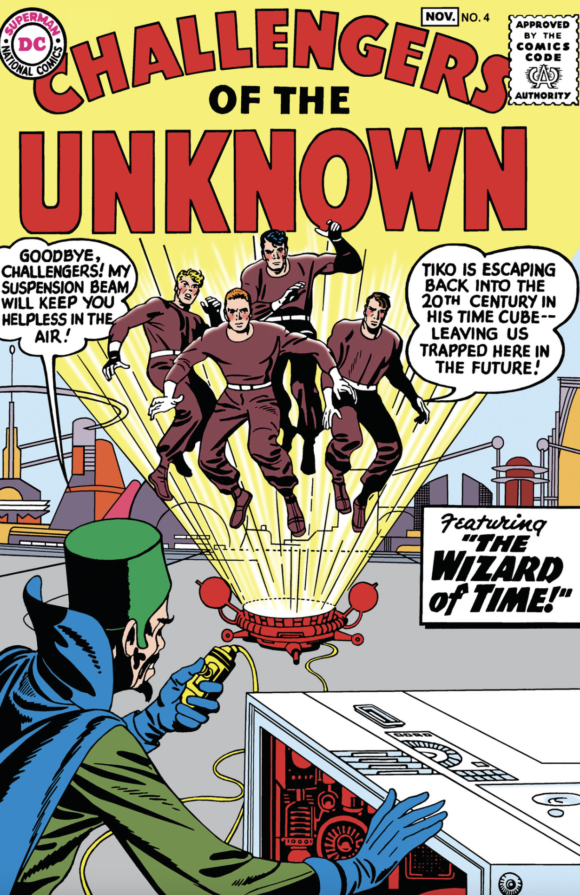
Kirby
Then, in 2003, DC gave Neal a present – they reprinted hardcover collections of Challengers of the Unknown. Neal was obsessed. The day it hit the stores, Neal handed me a wad of cash, told me to go to Midtown Comics and buy as many copies of the Challengers Archives as I could. The first hardcover featured the Showcase stories and Issues #1 and #2 from the regular series. It was the second hardcover, released in 2004, that was the REAL magic. Issues #3 through #8. These stories were when Kirby and Wood really hit their stride. The rest of the day was lost to poring over the Challengers stories until…
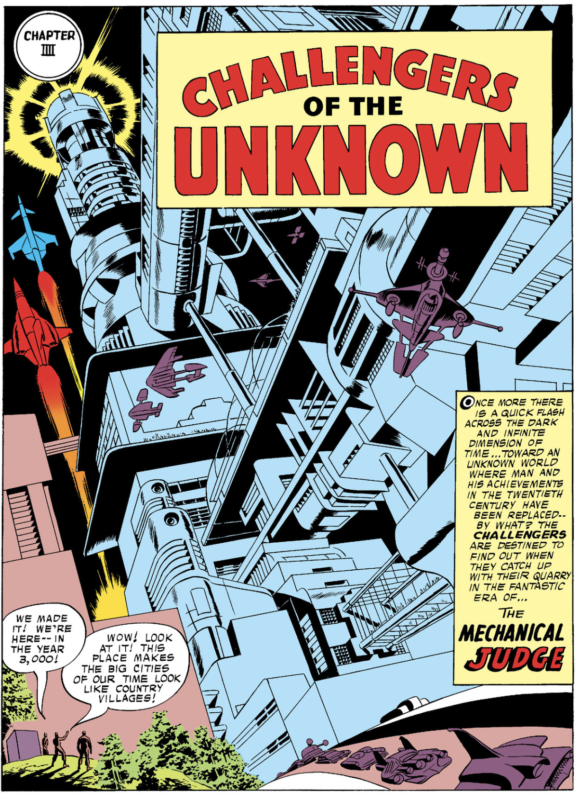
… Issue #4! Chapter 4, “The Mechanical Judge”! The splash page was exactly what Neal was looking for. It had changed the way Neal viewed Jack Kirby when he was just getting into comics. Jack was writing and pencilling these stories and this was Neal’s Dream. His theory was always that artists should be writing their stories. They understood storytelling better than writers, according to Neal. A writer was there to add dialogue and that was “the icing on the cake.” But, in this case, it was the splash page image that blew his mind.
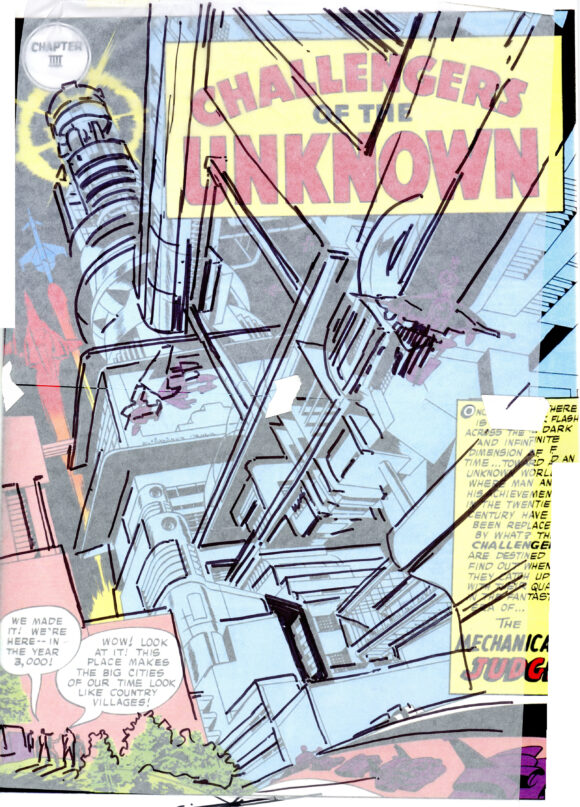
With Adams’ overlay
It was all about perspective. Kirby had drawn a futuristic, sci-fi building where the reader can see the bottom, middle and top clearly. The middle of the building is the focus and closest to the reader. However the top of the building AND the bottom of the building curve away and get smaller. Neal would always say it’s wrong but absolutely fascinating. Neal once drew a couple other examples of what Kirby was doing with perspective. The first is a boat with three men in it where the front of the boat comes to a point and the back end of the boat does the same. The widest spot is the middle section. Neal viewed it very much like a cinematic technique; a fish-eye lens that adds drama to the image.
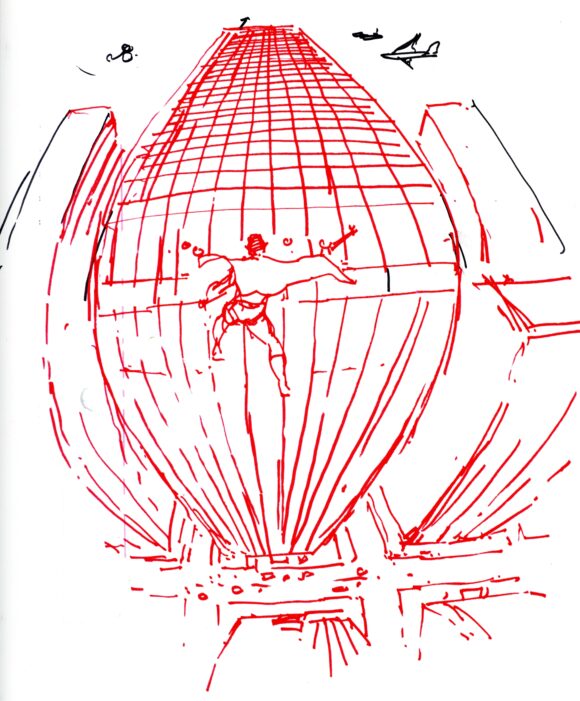
Adams doing Kirby
The second drawing is of a superhero character floating in the middle of a skyscraper. Again, the middle section is the widest and biggest while the peak of the building heads toward a single point. The bottom and the street does the same. Other artists who were fans of cinema or Kirby would do similar things. Michael Golden is a fan of Kirby and warps his images uniquely (especially in the G.I. Joe Yearbook), influenced by anime. Jason Pearson (in the brilliant Body Bags story “One Shot”) skewed the edges of a large panel so that the figures seem straight on, but the buildings around the edges are warped just slightly backward. It’s Kirby, but very, very subtle.
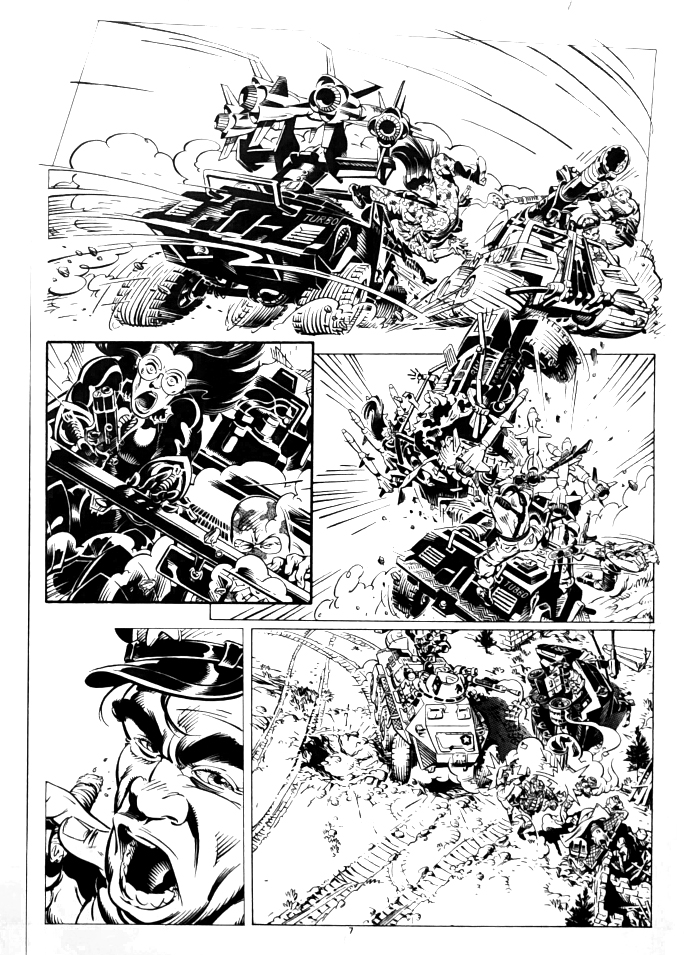
Golden’s GI Joe Yearbook
As a side note: One of my fondest memories was sitting quietly in Continuity’s conference room with Neal, Michael Golden and Larry Hama talking about that Pearson panel. The legends of the industry blown away by how good an artist Pearson was… and how intelligent. Not often can you get those three to agree on art. Later Neal did the “here’s money. Go buy a bunch of Body Bags. I want to always have one available.” I returned with probably 10 copies.
Earlier, when Neal was 27 in the late ’60s, he started to realize how unique Kirby was. Fantastic Four was obviously a heightened version of the Challengers. Then, the Hulk, the Avengers, the (almost throwaway) X-Men, Ant-Man, Thor, Black Panther, a revised Captain America and so many others. Neal drew Deadman, Green Lantern/Green Arrow, Batman, Avengers, the X-Men and so much more while Jack Kirby was changing the comic universe. Neal saw that every page of a Jack Kirby comic had a boldly new idea that someone else could explore and turn into a regular series.
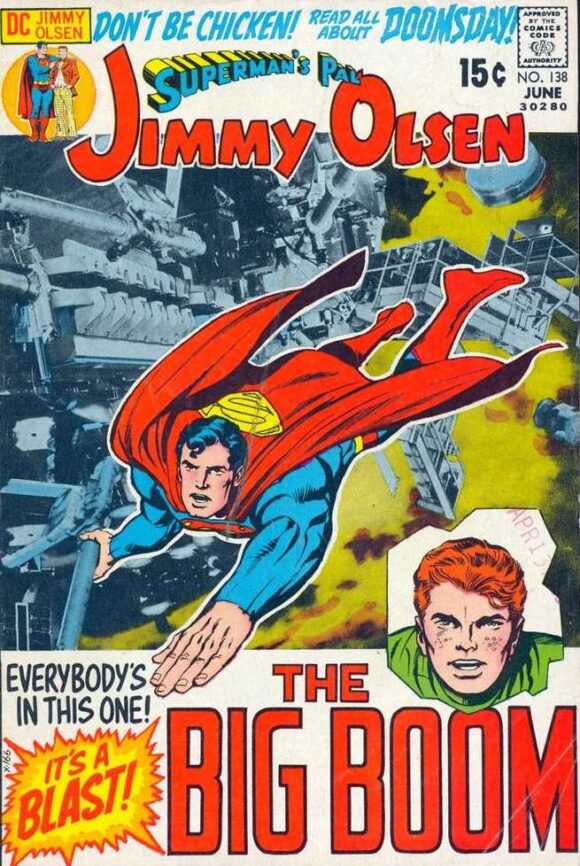
Kirby pencils, Adams inks
Before Neal finished his 1968-74 run at DC and Marvel, Jack left Marvel and went to DC where he created the New Gods. Neal also told me that Jack used the things that people were thinking about at the time. The Hulk, the Fantastic Four, and the X-Men were created by mutation and, in the Hulk’s case, the atomic bomb. Of course he would create these characters in the midst of the Cold War. Then when he had to create a new universe for DC, he went to what superheroes really are – gods. Neal said Jack took the most obvious thing and augmented it into superheroes. There are old gods… why not create “the new gods”? Oh, and throw in some other characters like the Demon or OMAC or Sandman. Then there was the Planet of the Apes seen through the eyes of Kirby which became Kamandi.
Then there came the day that Jack left DC Comics, returned to Marvel but was still unhappy with the company’s treatment of him, Jack “King” Kirby went to Hanna-Barbera where he worked on a ton of animation. Around the same time, Neal was approached by Pacific Comics to write and draw a creator-owned comic. Neal created Ms. Mystic for them. Always to be one to help everyone else, Neal called some friends to get in on the created-owned fun. Sergio Aragones created Groo, which still appears today. Then, he called Jack.
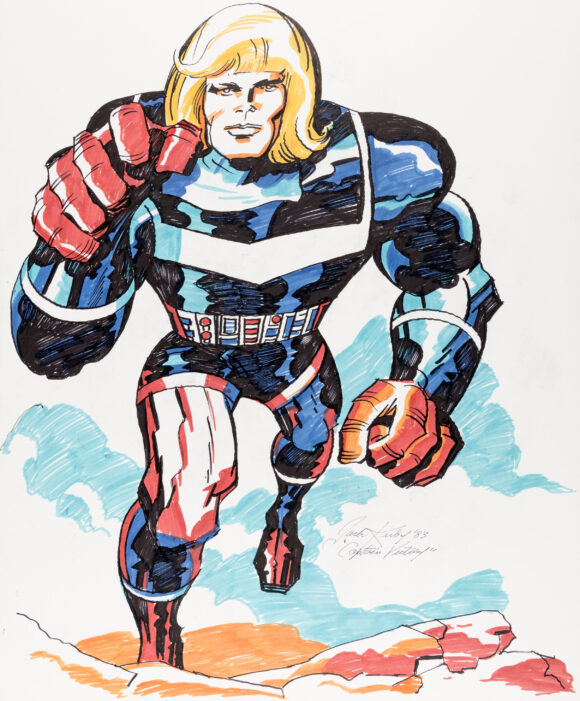
Kirby
Jack, having worked his entire life in a work-made-for-hire world, refused to believe that he could own his own character. As Neal told the story, several conversations were had between Jack and him before Kirby finally agreed to work with Pacific Comics. There he created Captain Victory and the Galactic Rangers as well as Silver Star. Having Neal, Jack and Sergio on board brought more talented creators to the fledgling company. Mike Grell on Starslayer, Steve Ditko on Missing Man, John Byrne on Rog 2000 and even Dave Stevens on The Rocketeer. Neal, always fighting for creator’s rights, could not have been happier to provide the “King of Comics” with a place where he could create his own characters – AND OWN THEM!
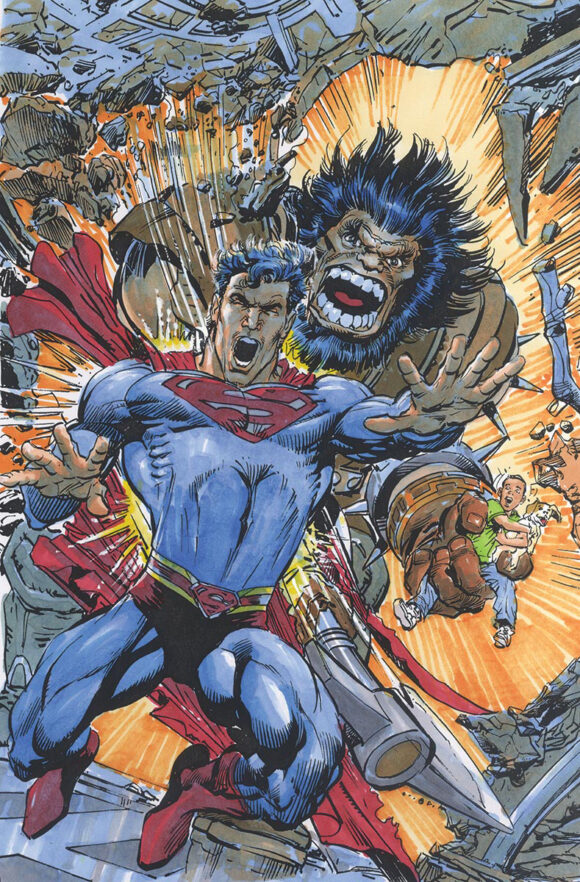
Coming of the Supermen
Now, Neal was not really a fan of Kirby’s drawing but he LOVED Kirby’s creations and sense of design. Neal loved Jack’s New Gods characters so much that he used them for his Superman mini-series, The Coming of the Supermen. Neal’s version of Darkseid is terrifyingly evil. Neal’s Kalibak is a monster. Neal’s Granny Goodness is your worst bad grandma nightmare. Neal also added a new character into the Fourth World mythos during his six issues.
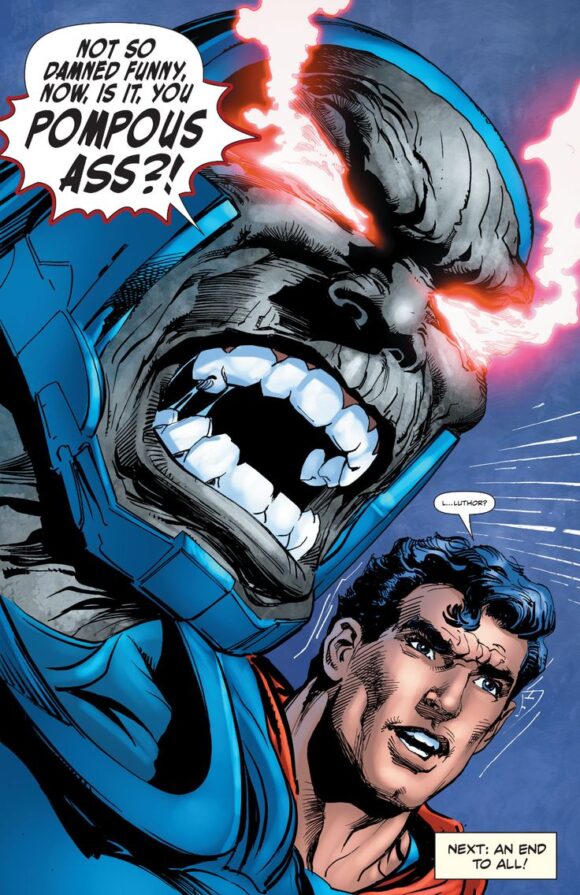
Coming of the Supermen
And he even drew an issue of Kamandi, but was disappointed that the script wasn’t “Kirby crazy,” he said.
We’ve probably all seen Neal finishing Jack’s Superman on the Jimmy Olsen covers he inked. Neal said he loved the freedom and lack of constraint Jack had. When a sea monster came out of the ocean, it was HUGE and needed a double page spread. Photographs turned black and white as backgrounds. Galactus! The Silver Surfer! The Inhumans! Boom Tubes! The Pact! Neal drew all of them and loved every moment of the experience.
—
MORE
— Dig These 13 Unpublished JACK KIRBY MARVEL Covers. Click here.
— COMIC BOOK DEATH MATCH: Jack Kirby’s FANTASTIC FOUR vs. Jack Kirby’s THOR. Click here.
—
Peter Stone is a writer and son-in-law of the late Neal Adams. Be sure to check out the family’s twice-weekly online Facebook auctions, as well as the NealAdamsStore.com, and their Burbank, California, comics shop Crusty Bunkers Comics and Toys.

September 17, 2023
It’s worth noting that, though Infantino may have asked for a Planet of the Apes knock-off, what he got was a mash-up of two old Kirby ideas: a hero from his strip proposal “Kamandi of the Caves” and a future of intelligent animals from his Alarming Tales story “The Last Enemy.” If you know anything about Kirby, you won’t be surprised that both of these preceded Pierre Boule’s novel, “Planet of the Apes.”